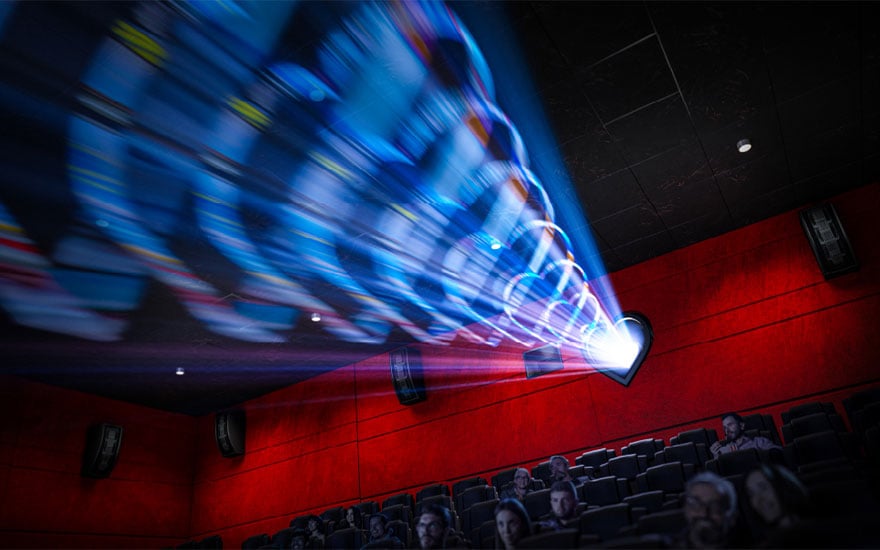Find out what makes this projector shine
Have you heard the good news? One of Christie’s projection systems recently won an Academy Award®. The award, specifically a Scientific and Engineering Award for the design and development of the Christie® E3LH Dolby® Vision Cinema Projection System will be presented to principal product developer Mike Perkins, who led the creation of this projector and will accept the award on behalf of the team who developed it.
We recently talked to Mike, Darren Hoffman, senior program manager, and Edwin He, senior product developer, all part of the team responsible for the development of the E3LH, about the technology and what makes it worthy of an Academy Award.
According to the Academy, the award honors “individuals and companies whose discoveries and innovations have contributed in significant and lasting ways to motion pictures” – no small feat.
The team pointed out a few key innovations. Let’s shine a light on them.
The first projection system with High Dynamic Range
In 2011, Dolby presented a vision of the future of cinema to the Christie team, and it included High Dynamic Range (HDR). HDR was a feature of their high-end monitors, and they were looking for a partner who could create a projection solution that would bring the same spectacular image quality to the big screen – specifically, high-contrast visuals.
Christie began to develop what would eventually become the E3LH. By 2015, the team had a finished product, which was used to screen the film “Tomorrowland”.
The biggest difference between a typical cinema projector and the E3LH? A massive increase in contrast and specifically black levels. Contrast jumped from 2,000:1 on a typical cinema projector to a whopping 1,000,000:1. “Practically speaking, HDR means you can see more details in the darkest areas of the image,” says Darren. “HDR lets you do things that you cannot do in standard dynamic range, like have very low light levels on one side of the screen, and a bright flash or the sun on the other side of the screen, and make those dynamic, detailed visuals simultaneously on the same image.”
“This system uses standard content that’s remastered to achieve high contrast and high brightness,” adds Mike. “It’s a seamless process to achieve stunning on-screen visuals. The real key to this increase is cascaded DLP® and the spatial light modulator. The spatial light modulator converts light into an image by shining light onto an array of mirrors – the DMD - and then flips the mirrors to discard the light you don't need. The contrast ratio exists because there’s a limit to how much light we can ‘throw’ away.”
“This was innovative because, at the time, no one would have dreamed about throwing away that much light,” adds Darren.
“The optical path design of the projection system was completely new,” says Edwin. It was a breakthrough for the team when they synchronized two light engines in the E3LH.
“We had been working on RGB pure laser, and the timing for this project was perfect. It was just becoming a mature technology that we were able to leverage.” – Mike Perkins
The result of these innovations is that the system displays true black, without residual light, instead of the typical dark grey of digital projection. This is simple to say, but the impact is massive. “When I heard the idea the first time, I thought, ‘OK, why is that so exciting?’, but it really makes a gigantic difference to have the deepest blacks onscreen,” says Darren.
The E3LH is 2D- and 3D-capable, with unprecedented brightness in 3D. “With the E3LH’s higher brightness combined with its high contrast capabilities, you can see incredible details in content that just weren’t visible before,” says Mike.
Colors closer to what the human eye can perceive
The team’s second E3LH innovation is wide color gamut (WCG). WCG is a result of RGB pure laser illumination, which allows the color gamut to expand beyond the DCI-P3 color space, thanks to individual red, green, and blue lasers. It approaches 95% of the Rec. 2020 color gamut, which is the color space closest to what our eyes can perceive.
“We had been working on RGB pure laser, and the timing for this project was perfect. It was just becoming a mature technology that we were able to leverage,” says Mike.
The Rec. 2020 color space delivers a big impact on the quality of the visual experience. With a wider color gamut, content is more vibrant. It also creates the perception that the content is brighter. More lifelike colors make the audience experience more immersive, which helps filmmakers tell their stories and bring their visions to life. In short, everything the audience sees on-screen looks more realistic and feels more believable.
“Think about the difference in image quality between old tube TVs with newer LED TVs – that is similar to the difference in image quality between a digital cinema projector and the E3LH,” says Edwin.
Developing an award-winning projection system
When the E3LH made its debut for the premiere of “Tomorrowland”, it was the culmination of four years of work by the team. What started out as an impossible task moved to a series of less impossible tasks, then to a noisy, 600-pound prototype, and finally to an Academy Award-winning projection solution.
The Academy will present Scientific and Technical Awards at the Academy Museum of Motion Pictures on Friday, February 23, 2024.



